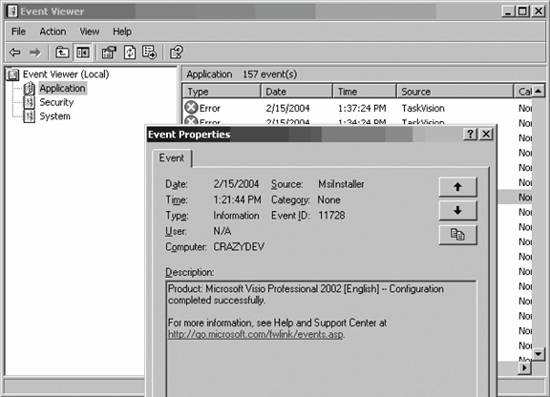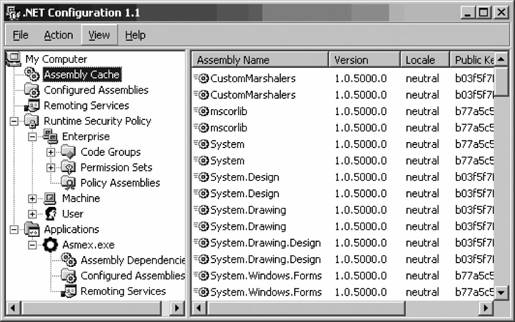9.9. Management Tools In this section, I'll look at both GUI and CLI management tools that you can use to administer the .NET Framework and your web applications with Windows Server 2003. 9.9.1. GUI Tools The GUI tools included with the .NET Framework are fairly limited, but worth a mention. They consist of two tools, the .NET Framework Configuration MMC and the .NET Framework Wizards. 9.9.1.1. The .NET Framework Configuration MMC This tool is apparently the greatest Microsoft has to offer in terms of graphical management of the .NET Framework. This is unfortunate, as this tool could use a lot of additions to the management of settings within XML configuration files. You can find the tool in the Administrative Tools panel in Windows. Figure 9-9 shows a snapshot of the tool. Figure 9-8. Event log entry created through tracing 
Enterprise Instrumentation Framework If you are really interested in diagnostics, I recommend you take a look at the Enterprise Instrumentation Framework (EIF). The EIF is a set of libraries designed to unify management and instrumentation in a .NET enterprise environment. Microsoft freely distributes the package as a separate download from the .NET Framework. Think of the EIF as tracing on steroids. Instead of simple text messages, events are raised from applications. Events can be structured to include more information than can be contained in a sentence or two. You can create custom events that can be related to a specific business process. As events are raised, they are sent to one or more sinks. These sinks can be anything, including a new Windows Trace Session Manager that has been created for very high-frequency logging. You can configure all of this through a centralized XML configuration file. |
Figure 9-9. The .NET Framework Configuration MMC 
I'll quickly cover the first level of the tree to give you a basic understanding of the tool: Assembly Cache is another view of the GAC Explorer extension that you also can find at %SystemRoot%\assembly in Windows Explorer, but without the drag-and-drop Add functionality. You can remove assemblies with it. Configured Assemblies is a summary of the assembly location and redirection settings from the machine.config XML configuration file. This provides a method to redirect references to an assembly on a machine basis. Remoting Services provides a very limited interface for manipulating the remoting section of machine.config. This interface does not allow you to add parameters, just edit those that exist. Runtime Security Policy is actually a nice interface for managing the security policy of the enterprise, the machine, or the current user. Applications allows graphical editing of an application's configuration file. The first time I saw this I thought it was a joke. Out of the hundreds of possible configuration parameters, this thing allows you to edit maybe 10 or 20 of the less important ones.
9.9.1.2. The .NET Framework Wizards tool The .NET Framework Wizards tool is designed to streamline some of the common operations that are typically done with the .NET Framework Configuration MMC. You can also find this tool in the Administrative Tools panel. The most notable function is the Adjust .NET Security Wizard. This provides an Internet Explorer-like panel for adjusting security based on zones. 9.9.2. Command-Line Tools The command-line tools provide a much more complete management solution for the .NET Framework. These tools are located in %SystemRoot%\Microsoft.NET\Framework\<version>\ except where otherwise noted. I'll touch on a couple of the highlights here:
ASP.NET IIS Registration Tool (aspnet_regiis.exe) This tool is useful if you have web applications that need to use different versions of the .NET Framework on the same machine. Installing different versions might sound like a management nightmare, but it is actually fairly simple with this tool. To set a web application to a specific version of the framework, use the aspnet_regiis.exe included with the version as follows: aspnet_regiis -s W3SVC/1/ROOT/Application
Code Access Security Policy Tool (caspol.exe) Although this tool performs virtually anything involved with administering security policy, it is useful mostly for the quick and dirty little tasks such as trusting a single assembly. To do that using caspol, you'd run the following command: caspol -m -ft assembly.dll
Global Assembly Cache Tool (gacutil.exe) Use this to install, remove, and list items in the GAC. This tool is included with the .NET SDK and is located in the install directory. To install an assembly, use: gacutil /I assembly.dll
Installer Utility Tool (installutil.exe) Performs actions needed to run an assembly after an XCOPY deployment. To use on an assembly, use: installutil assembly.dll
|

